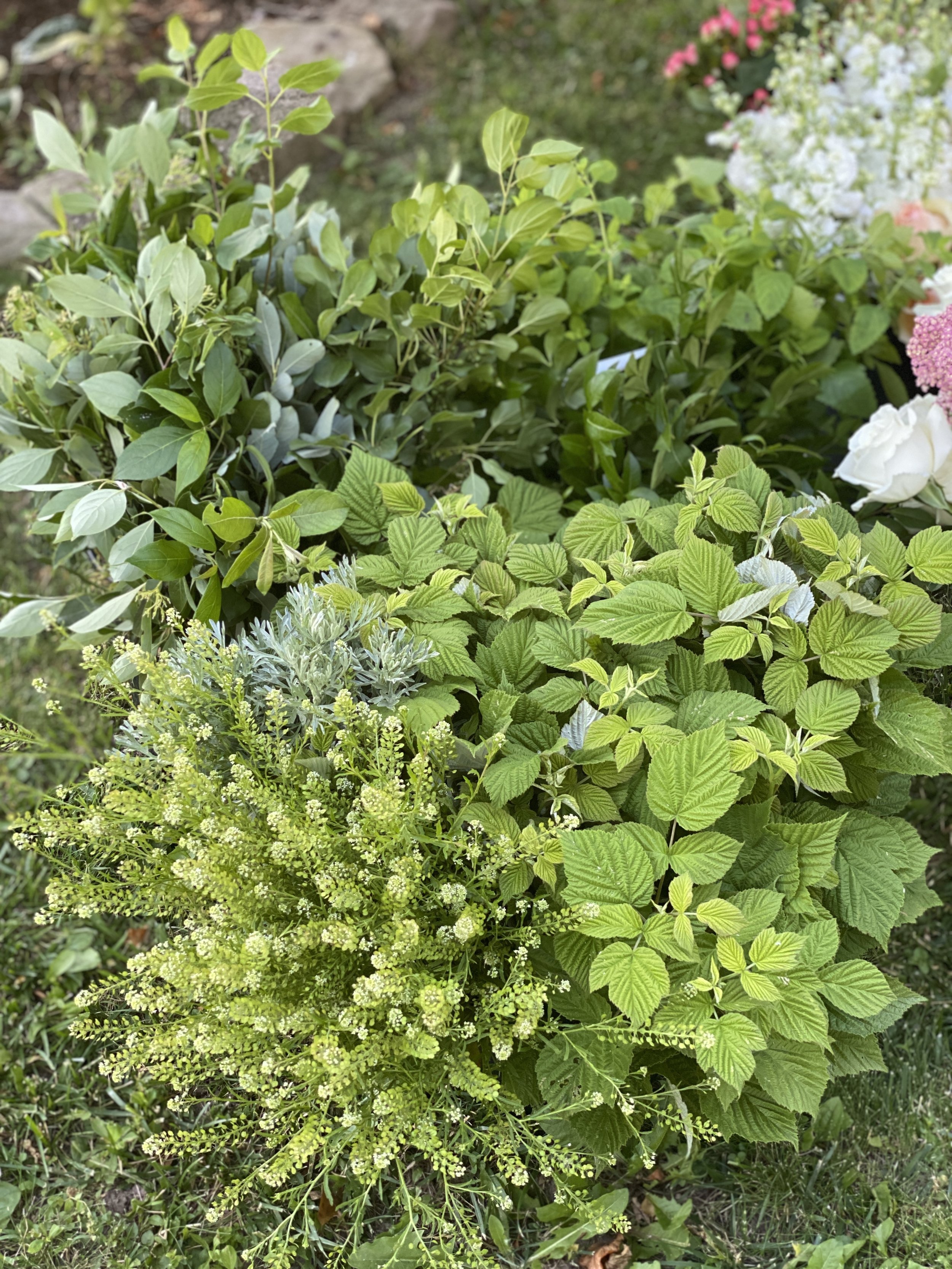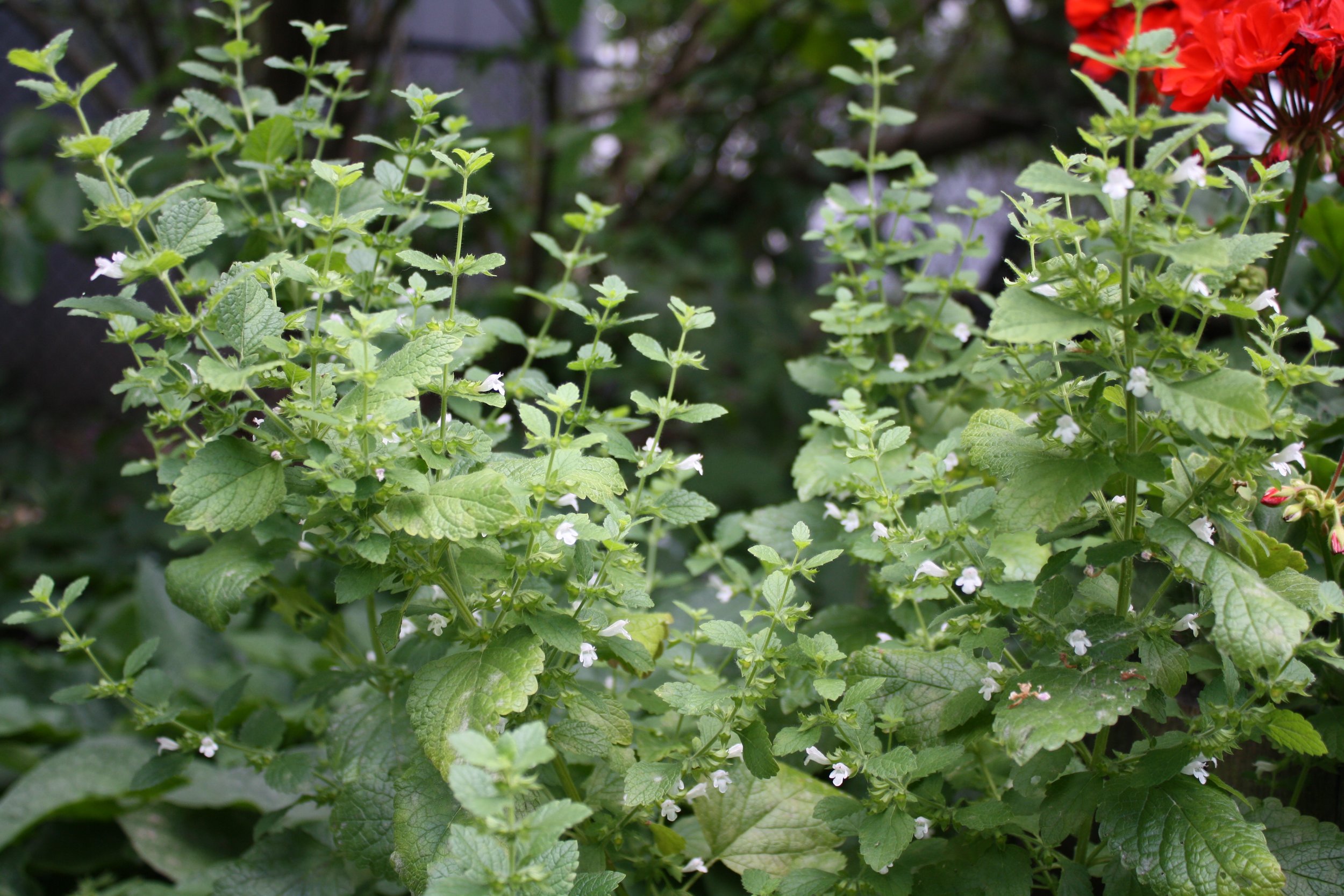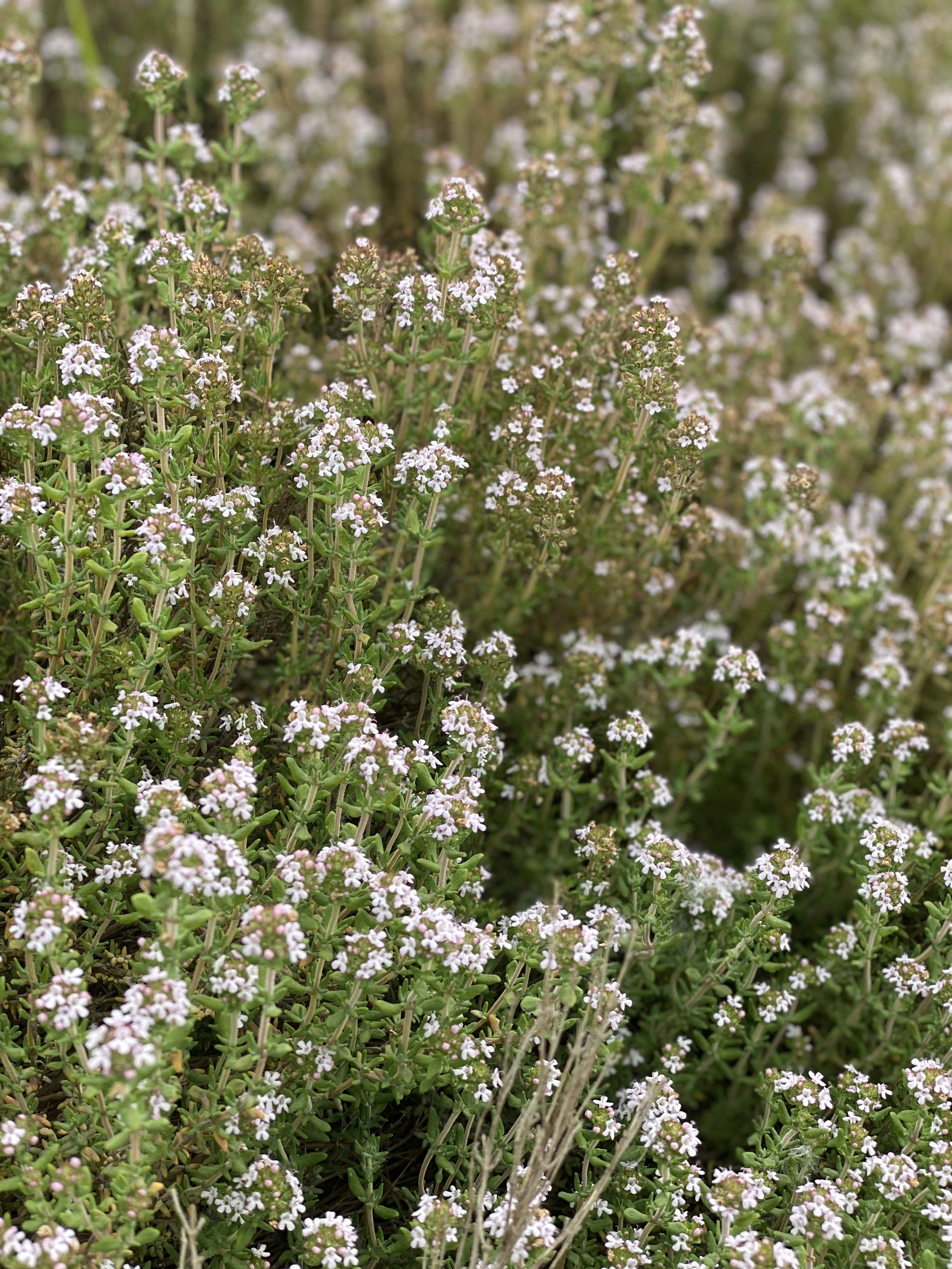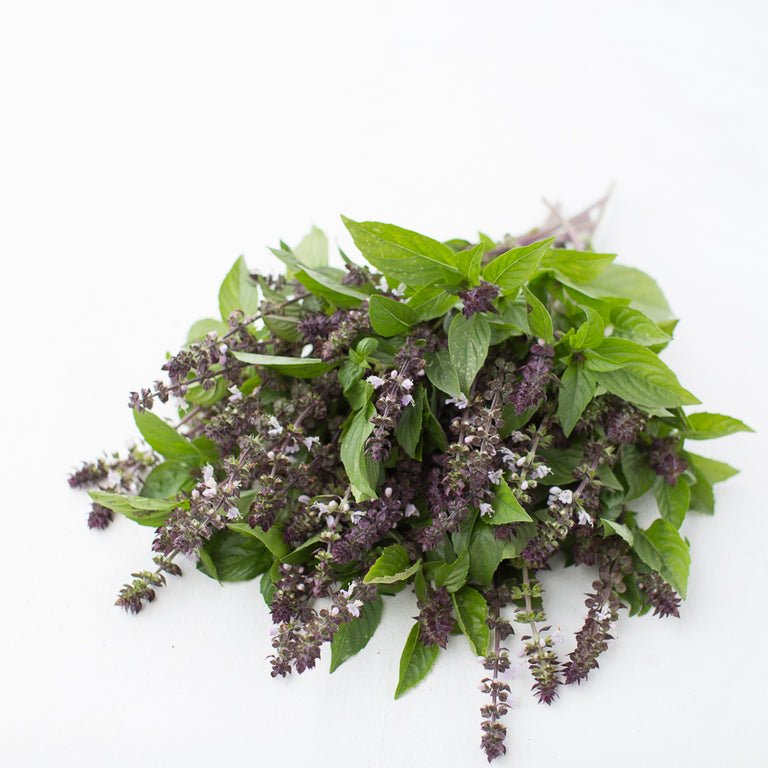Growing Cut Foliage: Top Foliage and Where to Source Plugs
Updated January 15, 2024
Big, colorful blooms get all the attention and hype in the floral design world, but every florist knows that at the base of good floral design, there is always beautiful foliage, even if it’s just a little bit.
As a cut flower farmer and wedding florist, I am really into growing seasonal, fragrant foliages on our flower farm. The most requested greenery (foliage) from our florists, whom we sell cuts directly to, are the deliciously scented varieties that are unavailable from the large wholesale flower distributor. Likewise, the foliage that gets the most attention from our consumers (people who buy wrapped bouquets, or our wedding couples) is the foliage that smells really good.
Scented foliage is what we go for. It’s necessary to use because most of the beautiful flowers we grow (dahlias, zinnias, cosmos, celosia, lisianthus, ranunculus, etc) actually do not have a scent at all! What’s the first thing people do when they receive a bouquet of flowers? They stick their face in it and give it a deep sniff. It’s important that our bouquets smell delicious, and we achieve this by sticking in lots of scented foliages like basil, lemon balm, and mints.
Related: How to Choose Flowers to Grow on Your Farm
My most favorite comment to hear from clients is, “I have never seen ___ or ____ or ____ used in a floral arrangement before!” I get this compliment a lot because I love using edible herbs and unsuspecting ingredients within our floral designs.
Below are my favorite foliages / greenery I grow on my Zone 6b flower farm in Burt, NY. I’ve included a short description of how I grow the plants and how I use the cuts in designs. I hope you’ll find the list helpful and inspiring for your own farmer-florist endeavors!
Favorite Cut Foliage We Grow on Our Flower Farm
lemon balm as cut foliage
Lemon Balm has a special place in my heart. I noticed it growing randomly in my backyard during 2020 when everything became so depressing during the COVID quarantine. Lemon Balm is known to be a natural anti-depressant, so I steeped its leaves in the sun to make a nourishing sun infusion to uplift my spirits.
Medicinal purposes aside, Lemon Balm smells like Froot Loops and is a gorgeous, wild addition to centerpieces and wrapped bouquets. Lemon Balm is a perennial in Zone 6 and comes back bigger and more vigorous every year! It does best in partial shade and must be harvested before the sun hits it in the morning or it will completely wilt. Every few years, lemon balm clumps should be dug up and divided into more plants. Make sure you choose a spot where you don’t mind it taking over forever. As a member of the mint family, it will spread and find a home for itself in most soil conditions but does best when amended with compost.
You can buy Lemon Balm plants in 12-packs or 90-count plug trays at Richters Herbs.
growing raspberries for cut foliage
I love growing raspberries for two reasons: they are super easy to grow (if you have enough space, more on that below) and the stems themselves take up a lot of space in arrangements and as such, are effective filler for large arrangements and installations.
Raspberry leaves grow on long woody canes and the leaves themselves are very hardy out of water. They hold up on hot days and give beautiful arching shapes to bouquets, arches, statement pieces and centerpieces. Raspberries are best planted bare root in the spring and they take a few years to fill in. Once established, you will have an endless supply of raspberry foliage (and delicious farm snacks as the berries ripen!) We grow the Encore and Nova varieties from Johnnys Selected Seeds, which are both “thornless,” meaning they don’t have huge thorns but the stems are still spiky so I wear gloves during harvest and design.
Related: Winterizing the Flower Farm Using No-Till Soil Building Techniques
It is very, very important that you understand how raspberries grow before you select an area to plant them in your flower farm. Raspberry roots spread laterally throughout the soil at an aggressive pace. They will literally take over an entire area and they do not care if you planted them in a straight, long row. Over the course of a few years, they will take over an entire area. To keep growth contained, you can use landscape fabric as pathways and you can also lay a thick (10 ft minimum) edge around the raspberry patch to help prevent them from spreading out. They still may eventually find their way out, though. Another thing to know is that deer will eat the foliage in the spring/summer, so you’ll need to have a deer fence around them.
growing applemint on the flower farm
Our most profitable cut foliage on the flower farm is, believe it or not, Applemint. Everybody loves Applemint. It is incredibly hardy (when harvested before the sun hits it) and lasts for up to 2 weeks in a vase. It’s edible and smells incredible. The pink flowers that bloom mid-season add a funky fun vibe to wrapped bouquets and vase centerpieces.
Applemint is the best mint to grow for cut flowers because it has a long stem length and gorgeous velvety leaves that look elegant in floral designs. The stems are tall and strong, as opposed to floppy and skinny like some other mints. It is true that Applemint has the potential to get completely out of control, but I’ve found that on the farm where it is being consistently cut back it hasn’t gotten too bad. I would recommend using landscape fabric around the edges of it to prevent it from spreading too aggressively.
You can buy an entire 90-count plug tray of Applemint from Richter’s Herbs, which is where I got mine from!
thyme as a cut foliage
Yes, thyme! This is one of my little secret weapons. Thyme is one of my favorite foliage for textural boutonnieres and definitely my favorite foliage for making flower crowns. It smells divine, holds up out of water, it’s perennial and therefore effortless to grow. Thyme is also adorable in bud vases with its tiny little white, purple or pink flowers (depending on the variety).
Growing thyme is easy. Thyme is drought tolerant and will grow in most soil conditions, as long as the soil drains well. Buy thyme transplants to get a head start and watch them take off! I have a small patch of 12-15 English thyme plants (pictured above) on my farm for my own use.
Richter’s Herbs (again! my favorite herb plug supplier!) has an incredible selection of Thyme plants and seeds here.
growing sage as a cut foliage
Sage has that gorgeous dusty, silvery sheen to it without being eucalyptus or dusty miller (which are also beautiful, but not necessarily perennial in our Zone 6b). Sage is gorgeous in wedding bouquets, boutonnieres, flower crowns, and low centerpieces. It is a perennial but many flower farmers grow this as an annual. I am growing Sage as a perennial cut foliage on my flower farm.
My favorite sage varieties are Berggarten, Tricolor and Purple. Sage begins flowering in the second year, and after gorgeous purple flowers (that are perfectly good for cutting by the way), Sage provides a steady supply of gorgeous greenery.
Get your Berggarten, Tricolor and Purple Sage in 12-packs or 90-count plug trays from Richter’s Herbs!
how to grow love-in-a-puff vine
Love-in-a-Puff Vine is another super special cut that adds a dainty, unique touch to arrangements. Love-in-a-Puff grows as a vine and produces long, super thin vines initially with little white flowers that turn into bobbing balloon-like seed heads. It is named “Love in a Puff” because the black seeds actually have tiny ivory hearts on them and the seeds grow inside these puff balls. Too cute, right?
I love using Love-in-a-Puff as a draping element in wedding bouquets, and I especially love using it as a finishing touch to statement pieces and table centerpieces. Allowing the vine to drape across the table in front of the centerpiece adds a magical touch to the entire display.
Related: The #1 Mistake You Can’t Make When Splitting Dahlia Tubers
I start Love-in-a-Puff seeds indoors, 8 weeks before planting out. They should be transplanted outside after danger of frost has passed in your growing zone. I’ve also successfully direct seeded these in the garden, but it takes longer for them to mature that way. You’ll notice lots of volunteers coming up in subsequent years, which could be an easy way to keep your Love-in-a-Puff patch going. It’s important to realize that Love-in-a-Puff must be trellised — it grows 6-8 feet long and needs support to grow vertically in the garden. To trellis, you could use 8-ft posts with hortonova netting. Secure the netting to the posts using zip ties or twine. For a permanent trellis, you could opt to use metal cattle panels or some other heavy duty metal fencing material that doesn’t need removing every year.
hydrangea foliage as a cut for wedding designs
I have a few Hydrangea arborescens plants in my backyard. Arborescens are the variety that grow on old wood, as opposed to the Paniculata varieties that grow on new wood. Pruning the Arborescens varieties are discouraged if you want flowers. My Arborescens shrubs produce ugly flowers in my opinion, so I actually use these shrubs for cut greens instead.
Hydrangea greens are a gorgeous shade of medium-dark green, and my stems grow in huge, taking up a lot of space at the base of a centerpiece. They are sold at premium pricing to florists. Hydrangea greens are not sold on the traditional wholesale market and offer an opportunity for local growers to fill that void!
Related: Why Local, Organically-Grown Flowers are So Important
wormwood as a cut greenery
One of my favorite cut foliages on the flower farm is Wormwood. A long-lived perennial and natural insecticidal plant, Wormwood is one of the most simply gorgeous and unique plants we grow on our farm. The handful on the left (above) was harvested in mid-June, which is early for ripe greenery on the farm. The Wormwood plant shown on the right (above) was photographed in August-September, when Wormwood starts getting really tall and branchy. Later on, tiny yellow pollen tips bloom in abundance. Wormwood is my silver-blue foliage plant and I no longer grow annual dusty miller.
Related: Organic Soil Amendments for Flower Farming
Wormwood spreads easily from seed and could become invasive if you’re not careful (it is an Artemisia, but does not have the same hyper-invasive qualities of its cousin, Mugwort). We chop it all down before it goes to seed toward the end of September. That said, you can very easily direct sow Wormwood in your farm. It is deer and all-animal resistant. It is drought tolerant and will grow in the crappiest soil on earth. I love Wormwood for her reliability and cuts as early as mid-June!
When cutting Wormwood for a cut foliage, be careful to do it early in the day before the sun beats down, or it will wilt. If it gets wilty, it will perk up in the cooler after a few hours.
where to buy wormwood plugs
Richters Herbs has 90-count plug trays of Wormwood. You could certainly try direct sowing the seeds, but sometimes buying plugs just works more effectively and ensures your crop to come.
best basil varieties for cut foliage
I’ve grown a ton of basil varieties for cut foliage: Thai, Lemon, Tulsi, Cinnamon (pictured above), Ruffles, Red Rubin, Dark Opal, Genovese, and Aromatto. The two best varieties for cut foliage, hands down, are Aromatto and Cinnamon. These two varieties in particular produce the longest stems. I want lemon basil to be a great cut, but it is just too short for most uses, so we no longer grow it.
Aromatto basil grows in more of a purple tone with purple flowers, while Cinnamon basil has green leaves with purple flowers. Both are lovely and, despite the stems being covered in flowers, I still consider this a foliage rather than a filler flower. I use it mostly to add incredible scent to bouquets and to fill in holes in table centerpieces.
where to buy basil plugs for flower farmers
Richters Herbs has an incredible selection of basil plugs and seeds. I love ordering from Richters to try out unique varieties that I can’t find through other plug suppliers.
Pycnanthemum muticum ‘Smooth Mountain Mint’
Pycnanthemum pilosum ‘Hairy Mountain Mint’
growing mountain mint on the flower farm
Mountain Mint is beloved by many cut flower growers, and for good reason. All varieties of Mountain Mint are cold hardy and perennial in most growing zones; they are drought tolerant; require little to no fertilization; and get bigger every year, producing huge yields of cut material. If you are a flower farmer and don’t have Mountain Mint, what are you even doing?!
My two favorite varieties are pictured above: Pycnanthemum muticum and Pycnanthemum pilosum.
Pycnanthemum muticum (above, left) produces gorgeous multi-stemmed cuts with sweet shaped leaves in a soft, sage tone. This variety is imperative to grow if you make mixed bouquets or have a bouquet CSA because it fills in holes very easily.
Pycnanthemum pilosum (above, right) produces single-stemmed cuts with a spray of dainty white flowers at the top, perfect as filler in wedding designs, especially attendant bouquets.
where to buy mountain mint plugs
Pycanthmum pilosum Mountain Mint Plugs can be sourced at one of my favorite Herb Plug suppliers, Richters, here: Mountain Mint Plugs
They also have Pycanthemum incanum Mountain Mint Plugs, which I haven’t grown myself, but looks lovely with pink blossoms.
other foliage we grow on the flower farm
While the above varieties of foliage are among my favorites, there are a few other ones we grow that are worth mentioning.
Hibiscus ‘Mahogany Splendor’ — A lovely annual burgundy foliage that matures toward the end of the season, perfect for fall designs. The leaves are similar looking to a Japanese Maple tree. Growing Mahogany Splendor from seed is easy. I love making tea with it.
Ninebark, burgundy and green varieties — We grow 5 different types of ninebark on our flower farm, all in different shades of green, orange and red. Ninebark tends to be a floppy cut early on in June, but is super hardy starting in August, when stems are mature on the shrub.
Diervilla ‘Kodiak Orange’ — I just planted this last summer and Diervilla has already proven to be a gloriously colorful cut foliage in the fall. The leaf shape is different from anything else in the field and I am tempted to buy more.
Sweet Annie — I absolutely love me some Sweet Annie for cut foliage. I particularly love using it in wrapped bouquets for the deliciously sweet scent, and also in tall arrangements for height. Sweet Annie gets super tall and is an annual that is easily grown from seed or direct sowing into the garden very early.
Baptisia — Plant a Baptisia plant and in a few years it will grow into a gigantic shrub with tons of cuttable stems for greenery. The color and shape of the leaves are very similar to Eucalyptus, which makes Baptisia a perfect substitute for Eucalyptus. Baptisia does not have a scent, but it produces greenery in abundance. We have a whole row dedicated to Baptisia on our farm!
Related: How to Grow Lisianthus
Two foliages I would love to try to grow in the future are: Rosemary and Scented Geraniums. I think I could pull off Scented Geraniums in our new hoop house as an annual cut foliage because it will grow vigorously enough and mature quickly enough for cuts in one season. Rosemary, on the other hand, won’t survive in our frigid winter temps and it doesn’t grow quickly enough to mature into long, cuttable material over one season. So until our growing zone gets hotter, I’ll have to wait on the rosemary.

















